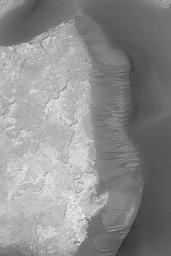
|
Kaiser Dune Avalanches
- Click the image above for a larger view
- Full-Res JPEG (540 x 810) (65.0 kB)
- Full-Res TIFF (540 x 810) (438.1 kB)
Caption:
MGS MOC Release No. MOC2-410, 3 July 2003
Mars Global Surveyor's (MGS) Mars Orbiter Camera (MOC) has obtained thousands of images of martian sand dunes since it began observing the planet from orbit in 1997. Many of the dunes appear to be inactive in the modern environment, but appear to be quite young, otherwise (they do not have any small meteor impact craters on them, they often have sharp edges and brinks--all attributes of modern, active dunes). In some dune fields, as in Herschel Basin in Terra Cimmeria, the dunes are grooved (e.g., see Mars Picture of the Day for April 19, 2003 ), indicating that they have been cemented and then eroded by wind. In the Noachis Terra region of Mars, many dune fields also appear to have been cemented. The evidence in this case comes from the deep scars formed on the slip face slopes by avalanches of sand. This MOC image shows more than a dozen examples a dune in eastern Kaiser Crater near 47.1°S, 340.0°W. If the dunes were not cemented--that is, if the sand was loose--then the avalanches would not leave steep-sided chutes on the slip face slopes. The implication that many martian dunes are cemented and inactive in the modern martian environment, but were active sometime in the not-too-distant past, suggests that the climate of Mars may have changed in recent times. This picture was obtained in June 2003; it is illuminated from the upper left. North is toward the upper right; the area shown here is about 3 km (1.9 mi) wide.
Cataloging Keywords:
| Name | Value | Additional Values |
|---|---|---|
| Target | Mars | |
| System | ||
| Target Type | Planet | |
| Mission | Mars Global Surveyor (MGS) | |
| Instrument Host | Mars Global Surveyor | |
| Host Type | Orbiter | |
| Instrument | Mars Orbiter Camera (MOC) | |
| Detector | ||
| Extra Keywords | Crater, Dune, Grayscale, Impact | |
| Acquisition Date | ||
| Release Date | 2003-07-03 | |
| Date in Caption | 2003-04-19 | 2003-07-03 |
| Image Credit | NASA/JPL/Malin Space Science Systems | |
| Source | photojournal.jpl.nasa.gov/catalog/PIA04610 | |
| Identifier | PIA04610 | |
